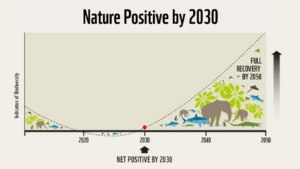New protections for two of Australia’s most vulnerable reptiles following decision at international wildlife conference SAMARKAND, Uzbekistan (3 Dec. 2025) ― Two of Australia’s most vulnerable reptile species have been awarded strengthened protections from international commercial wildlife trade following a decision today at the 20th meeting of the Conference of...
What is ‘Nature Positive’?
Australia is in an extinction crisis. With more than 2,000 nationally threatened species, the urgency for Australia to become ‘nature positive’ can’t be overstated.
But what does nature positive mean? Is it just more jargon or is it a genuine approach that can turn our extinction crisis around?
The concept of nature positive—to halt and reverse nature loss by 2030 (measured against a 2020 baseline) and achieve full recovery by 2050—was coined by a group of environmental organisations, sustainable businesses, and research institutions. It is an ambitious goal, yet one that is science-based, and measurable – much like the 1.5oC climate target under the Paris Agreement.
Nature positive has also been adopted through the internationally agreed Kunming-Montreal Global Biodiversity Framework. The Framework has a vision of a world of living in harmony with nature where ‘by 2050, biodiversity is valued, conserved, restored and wisely used, maintaining ecosystem services, sustaining a healthy planet and delivering benefits essential for all people.’

As a signatory to the Convention on Biological Diversity that will deliver the Framework, Australia has an obligation to implement it locally. In our case, that means through the national Environment Protection and Biodiversity Conservation Act 1999 (EPBC Act).
However, shortcomings in the EPBC Act were the subject of a scathing review in 2020. In response, the Australian Government announced its Nature Positive Plan in December 2022, committing to substantial reforms of the EPBC Act – the biggest overhaul for more than 20 years.
‘When we reform our environmental laws, we will take them from being nature negative, where we oversee an overall decline in our environment, to nature positive, where we protect our land and leave it in a better state than we found it,’ wrote Tanya Plibersek, the Minister for the Environment.
We are now in “Stage 2” of the Government’s EPBC Act reforms – a key stage for determining the future of nature positive. The Government’s draft legislation, currently before Parliament, creates its own definition of nature positive. If agreed, it would be the first time anywhere in the world that the term has been defined in law. It is therefore crucial that the definition is right; that it is clear, measurable, and able to hold decision makers to account. Currently it is not, it falls short.
‘Nature positive is an improvement in the diversity, abundance, resilience and integrity of ecosystems from a baseline’, it reads. The definition in the Government’s bill is vague, and ‘improving’ is a far cry from ‘halting and reversing’. At its heart, Australia must use the push towards nature positive to deliver on the commitments in the Global Biodiversity Framework and the Australian Government’s commitment to no new extinctions.
The bills should be amended to ensure the definition fully captures both species and ecological communities and sets a goal of recovery against a baseline consistent with the international definition of 2020. In our view, nature positive should be defined as:
‘An improvement in the diversity, abundance, resilience and integrity (meaning the completeness, functionality and health) of native species, populations and ecosystems from a 2020 baseline with a goal of halting and reversing nature loss by 2030 and achieving recovery by 2050’.

The Australian Government failed to pass its nature positive legislation in the final sittings of 2024. despite a clear and negotiated pathway to pass the legislation with appropriate amendments through the Senate crossbench.
At the time of writing, there remains an opportunity to urgently proceed with the reforms in early 2025, and HSI Australia encourages the Parliament to make the most of this opportunity if the currently scheduled sitting weeks proceed before an election is called.
Australia needs a nature positive future if it’s to have a future at all. And the responsibility falls on all of us—the community, the private sector, and all levels of government—starting with the introduction of appropriately amended nature positive laws.
The passage of genuine nature positive laws must be a top priority of Government. Nature simply can’t afford to wait.


